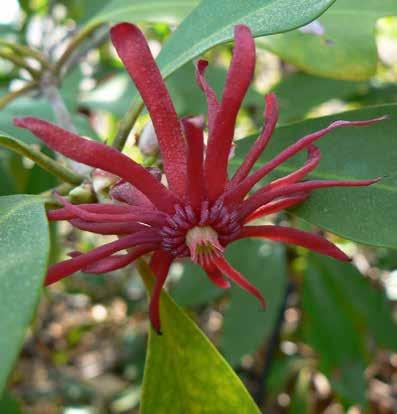
3 minute read
Mary Tucker
Florida anise bloom. Photo by Mary Tucker.
Native Anise
Advertisement
The (Almost) Perfect Shrub
BY MARY TUCKER
Is anise the perfect shrub? Well, there’s probably no such thing, but it surely comes close, in my opinion. It has all of these characteristics going for it: native to the Southeast, evergreen, deer-resistant, low-maintenance and resistant to diseases and insect pests.
There are two species of anise that are native to the Southeast, Illicium floridanum (Florida anise) and Illicium parviflorum (yellow anise). The two species have somewhat different ranges, but both are found in the lower parts of the Southeast. Fortunately for gardeners, anise is quite happy and cold-hardy in U.S. Department of Agriculture Hardiness Zones 7 through 10, making it a suitable landscape plant throughout most of Georgia. I grow both in my Cherokee County garden, but I have heard that yellow anise is slightly more cold-hardy than Florida anise.
In the garden, one of anise’s most useful characteristics is its evergreen nature. In both species, the elliptical, leathery leaves grow 4-6 inches long and have an attractive glossy sheen. The leaves emit a pleasant, spicy, anise-like fragrance if brushed against, but these aromatic compounds are poisonous, which makes the plant resistant to deer browsing and to insect infestation.
Despite their overall similarities, these species have very different blooms. Florida anise bears dramatic, dark-red blooms, about 1-2 inches in diameter. These springtime flowers are star-shaped with many straplike petals, giving them a bit of an otherworldly look. Some say the flowers have an unpleasant fragrance, but I’ve never detected any malodorous scent. In contrast, the blooms of yellow anise are small, cupshaped flowers that are light yellowish-green and only about a half-inch wide.
The flowers of both species are followed by lightgreen, multi-pointed, star-shaped fruits that develop into brown seed pods that look similar to culinary anise. But be warned – these fruits, like the foliage, are toxic.
Both species of anise grow in an upright, compact, rounded habit and produce multiple stems. They also spread by suckers, and roots will form where the lower branches touch the soil. This makes it easy to propagate them to obtain new plants. They form large shrubs or small trees, usually growing to a height of 8-12 feet with a similar spread.
In their native ranges, anises are most often found in low, damp, understory areas such as wooded ravines and stream sides. Given the natural habitat, anises prefer partial shade and moist soil and will wilt in drought; however, I find that they quickly recover when given water.
In my garden, both of these anises have been very low maintenance. I never have needed to prune either for height, though I understand they are amenable to that practice if you want to keep them shorter. The only issue I’ve had is when one spreads via suckers and starts to overtake nearby plants. Then, I simply and easily pull up the unwanted pieces, potting them up if I want to share with friends.
An anise has many uses in the landscape if you provide it with partial shade and moisture to suit it. Given its evergreen nature, it’s perfect as a screening plant or hedge. It also makes a lovely specimen shrub at the edge of the woods where the dark-green foliage provides contrast to bare trees in the winter landscape.
Where can you procure this almost-perfect shrub? Yellow anise will be available at the Cherokee County Master Gardeners’ spring plant sale, 9 a.m.-noon, April 30, at the Cherokee County Senior Center at 1001 Univeter Road in Canton. In addition to selling plants, Master Gardeners will be on hand to answer your gardening questions.
Mary Tucker is a North Carolina native who has lived in Cherokee County for more than 25 years. She is a Lifetime Master Gardener whose special interest is gardening with native plants.









